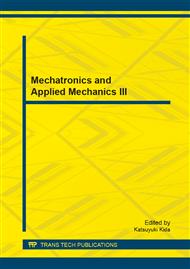p.147
p.152
p.157
p.165
p.170
p.175
p.179
p.183
p.187
Design of a Remote-Controlled Basketball-Playing Mobile Robot
Abstract:
This paper depicts the system design of a basketball-playing robot named BPR. BPR is a wheeled mobile robot equipped with a 3-DOF manipulator and a mechanical claw. The robot can grasp one basketball and then dunk under the players remote control. In this paper, the hardware design including the mechanical structure and the electrical system are introduced firstly. Then, the kinematic analysis of the manipulator is proposed to decide the manipulators posture control. Finally, simulation of the manipulator is implemented in ADAMS to verify the design efficiency of posture planning. BPR has been exhibited in a science museum in China and it is well welcomed by the audiences.
Info:
Periodical:
Pages:
170-174
Citation:
Online since:
February 2014
Authors:
Keywords:
Price:
Сopyright:
© 2014 Trans Tech Publications Ltd. All Rights Reserved
Share:
Citation:


